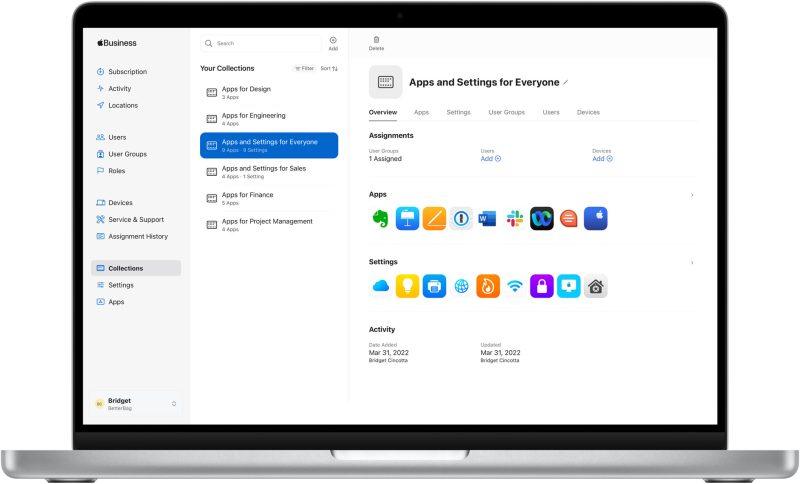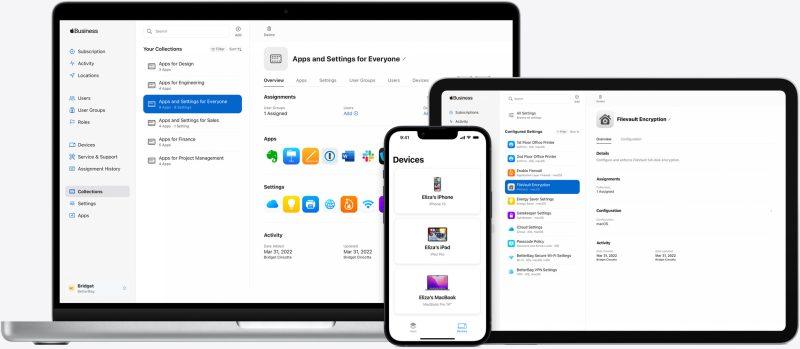Deploying and managing Apple devices efficiently is essential for productivity and security. That’s where Apple Business Essentials and Apple Device Manager come in. These complementary solutions simplify IT workflows, from device enrollment to app deployment and data protection. In this guide, we’ll explore both services in depth, step-by-step workflows, FAQs, and best practices.
Table of Contents
- What Is Apple Business Essentials?
- What Is Apple Device Manager?
- Apple Business Essentials Core Features
- Apple Device Manager Explained
- What is Master Data Management (MDM)?
- 🔄 MDM vs. MDM: Master Data Management vs. Mobile Device Management
- How Apple Business Essentials and Apple Device Manager Work Together
- Apple Device Manager How‑To Guide
- Benefits for Small and Midsize Businesses
- Best Practices
- Frequently Asked Questions
- Conclusion
What Is Apple Business Essentials?
Apple Business Essentials is Apple’s all‑in‑one subscription service designed for small to midsize businesses. It combines:
- Device management
- iCloud storage
- AppleCare support
into a cohesive package. This makes it easy for small IT teams to manage devices without investing in external MDM solutions.
What Is Apple Device Manager?
It is the underlying platform Apple uses to streamline device registration, enrollment, and supervision in business environments. Think of it as the backbone that allows ABE (or any MDM) to configure devices automatically—from unboxing to ready-to-use.
Apple Business Essentials Core Features
1. Automated Device Enrollment
With Apple Business Essentials, devices purchased from Apple or authorized resellers are automatically enrolled via Apple Device Manager. No manual configuration is required.
2. Configuration Profiles
Through Apple Business Essentials, you can push Wi‑Fi credentials, VPN settings, email accounts, and security policies. These profiles are enforced using Apple Device Manager protocols.
3. App Distribution
The service integrates with Apple’s Volume Purchase Program to push essential business apps. Using Apple Device Manager, apps install silently and remain managed, even if the user leaves.
4. iCloud Storage and Data Protection
Each user gets managed iCloud storage ensuring company data stays secure. With Apple Business Essentials, backups are automatic, and data can be remotely wiped if needed through the Device Manager interface.
5. 24/7 AppleCare Support
Plan tiers include AppleCare coverage and support from Apple experts, giving businesses peace of mind and dedicated assistance through device issues.
Apple Device Manager Explained
Behind the scenes, Apple Device Manager offers:
- Device supervision for higher privileges
- Zero‑touch enrollment via Automated Device Enrollment
- Configuration profile delivery (Wi‑Fi, VPN, restrictions)
- App and content assignment via VPP
- Remote wipe and lock capabilities
- Device status monitoring and reporting
It works with Apple Business Essentials, other MDM platforms, or directly via Apple-provided tools.


What is Master Data Management (MDM)?
Master Data Management (MDM) is a set of technologies, processes, and policies used by organizations to ensure that their core business data—also known as “master data”—is consistent, accurate, and uniform across all systems and departments.
📌 What Is “Master Data”?
Master data refers to critical business entities that are used repeatedly across systems and operations. Common examples include:
- Customer data (names, contact info, customer ID)
- Product data (SKU, descriptions, specifications)
- Supplier or vendor data
- Employee data
- Financial or account structures
💡 What Does MDM Do?
Master Data Management provides a single, authoritative source of truth for each of these data types. It ensures that:
- Everyone across the company sees the same version of a customer, product, or vendor
- Data is clean, non-duplicative, and standardized
- Changes to master data propagate consistently across systems (e.g., CRM, ERP, analytics)
⚙️ How MDM Works
An MDM system typically includes:
- Data Integration – Consolidates master data from different applications (e.g., Salesforce, SAP)
- Data Cleansing – Detects and fixes inconsistencies, duplicates, and missing fields
- Data Governance – Applies policies to define ownership, approval workflows, and access controls
- Data Stewardship – Human oversight to manage data quality and enforce rules
- Golden Record Creation – Produces a single, trusted version of the data (“golden record”)
✅ Benefits of MDM
- Improved data quality and consistency
- Enhanced decision-making based on accurate reporting
- Operational efficiency (less rework, fewer errors)
- Better customer experience (consistent records across touchpoints)
- Regulatory compliance through controlled, auditable data practices
🧠 Who Uses MDM?
MDM is common in:
- Large enterprises with multiple systems or data silos
- Retail & eCommerce for managing product catalogs
- Finance & insurance to handle customer and policy data
- Healthcare for patient identity management
- Manufacturing to standardize parts and supplier data
🔄 MDM vs. MDM: Master Data Management vs. Mobile Device Management
| Feature / Aspect | Master Data Management (MDM) | Mobile Device Management (MDM) |
|---|---|---|
| Purpose | Ensures consistency and accuracy of business data | Secures and manages mobile devices used in organizations |
| Primary Focus | Data entities like customers, products, suppliers | Smartphones, tablets, laptops (iOS, Android, Windows, macOS) |
| Used By | Data teams, analysts, IT for data integration & governance | IT administrators and security teams |
| Core Functionality | Data cleansing, deduplication, integration, governance | Device enrollment, remote wipe, app management, policy enforcement |
| Example Use Case | Creating a unified “customer” profile across systems | Remotely locking a stolen company phone |
| Key Tools/Platforms | Informatica, IBM InfoSphere, SAP MDG, Oracle MDM | Jamf, Microsoft Intune, VMware Workspace ONE, Kandji |
| Benefit | Better analytics, operational efficiency, data compliance | Device security, productivity, and centralized control |
| Deployment | Cloud/on-premise integration with enterprise data systems | Cloud-based or hybrid; integrated with Apple or Android platforms |
| Compliance Focus | Data accuracy and audit trails | GDPR, HIPAA, device encryption, remote access |
💡 Summary
- Master Data Management is about data: making sure names, addresses, SKUs, and other records are accurate and harmonized across business systems.
- Mobile Device Management is about hardware: managing the security, apps, and policies of mobile and endpoint devices in a network.
Despite sharing the acronym “MDM”, they solve completely different problems for IT and business teams.
How Apple Business Essentials and Apple Device Manager Work Together
Step 1: Purchase Devices
Buy devices directly from Apple or an Apple-authorized supplier and register them for Automated Enrollment with Apple Device Manager.
Step 2: Set Up Apple Business Essentials
Create an account, choose a subscription tier, and add managers. During setup, link to Apple Device Manager for device onboarding and supervision.
Step 3: Pre‑Configure Device Settings
In Apple Business Essentials you define policies—Wi‑Fi, security restrictions, app bundles—all deployed via Apple Device Manager when devices are turned on.
Step 4: Adding Users and Devices
Assign devices to users in Apple Business Essentials. These devices automatically enroll through Apple Device Manager and receive customized configurations.
Step 5: Day‑to‑Day Management
Monitor device status, enforce policies, deploy updates, and troubleshoot issues—all from the Apple Business Essentials portal using Apple Device Manager technology.
Apple Device Manager How‑To Guide
How to:
Register Devices
- Go to Apple Business Essentials portal
- Upload your devices or add purchase order info
- Devices are automatically added to Apple Device Manager enrollment queue
Configure Profiles
- Create profiles in Apple Business Essentials
- Select devices or users
- Apple Device Manager pushes profiles on next login
Distribute Apps
- Buy app licenses via Apple Business Essentials
- Assign them to device groups
- Apple Device Manager installs apps silently
How to Enforce Security
- Create passcode and encryption policies
- Apple Device Manager enforces and monitors compliance
- Flag or wipe non-compliant devices automatically
Benefits for Small and Midsize Businesses
- No third-party MDM needed: Apple Business Essentials + Apple Device Manager handles everything
- Cost-effective: Bundled cost for support, enrollment, device management
- Simple interface: Centralized portal for admins and users
- Secure by design: Supervision and iCloud backups keep data safe
- Scalable: Add or remove devices and users without reconfiguration
Best Practices
- Always enroll devices via Apple Device Manager to ensure supervision
- Use configuration profiles to standardize settings across teams
- Regularly review iCloud backup settings within Apple Business Essentials
- Assign user roles so technicians and admins have appropriate access
- Monitor device compliance —Wizard alerts for encryption, OS updates, or security issues
Frequently Asked Questions
Can I use Apple Device Manager without Apple Business Essentials?
Yes. Other MDM solutions also integrate with Apple Device Manager via Automated Enrollment for supervision.
How many app licenses can I assign?
Apple Business Essentials supports bulk purchasing via VPP; use Apple Device Manager to silently deploy apps to devices.
What happens when a device is lost?
Use Apple Device Manager to remotely lock or wipe the device. If services are lost, AppleCare via Business Essentials can assist with lockouts.
Does Apple Device Manager support Shared iPads?
Yes. Shared iPad functionality is supported in configurations managed via Apple Business Essentials.
Can I downgrade or upgrade my subscription?
Absolutely. Apple Business Essentials is subscription-based, and tiers can be changed at any time.
Conclusion
When IT teams ask, “What’s the difference between apple business essentials and apple device manager?”, know that they’re complementary parts of Apple’s ecosystem. Apple Business Essentials provides an all‑in‑one service including support, backups, and app distribution. Apple Device Manager is the underlying engine enabling device supervision, enrollment, profile deployment, and security enforcement.
By leveraging both solutions together, businesses get:
- Effortless device setup and onboarding
- Consistent configuration standards at scale
- Built-in protection and disaster recovery
- Seamless app distribution
- 24/7 Apple support
These tools help small and midsize organizations achieve enterprise-grade device management without the complexity of traditional MDM systems.

Andrej Fedek is the creator and the one-person owner of two blogs: InterCool Studio and CareersMomentum. As an experienced marketer, he is driven by turning leads into customers with White Hat SEO techniques. Besides being a boss, he is a real team player with a great sense of equality.
